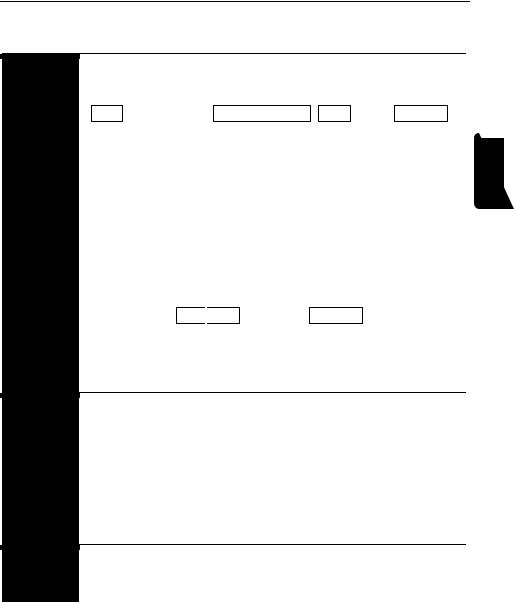
LAW / Referencing for Law Students / AGLC 3rd ed
.pdf
Australian Guide to Legal Citation 231
21.2Legislative Materials
21.2.1Statutes and Subsidiary Legislation
Rule Singaporean legislation and subsidiary legislation that has been assigned a chapter number should be cited as follows:
Title (Singapore, cap Chapter Number , Year rev ed) Pinpoint .
The title should adhere to rule 3.1.1. Where a statute or subsidiary legislation is cited as in force, the year is that of the most recent revision. For historical references, the appropriate year of revision should be included. Pinpoint references should adhere to rules 3.1.4– 3.1.6 and 3.3.2.
Legislation and subsidiary legislation that has not been assigned a chapter number or been revised (as well as historical statutes and subsidiary legislation that preceded chapter numbering) should be cited as follows:
Title 
 Year (Singapore) Pinpoint .
Year (Singapore) Pinpoint .
The year is that in which the statute was passed or the subsidiary legislation was promulgated originally (and should adhere to rule 3.1.2).
Examples Adoption of Children Act (Singapore, cap 4, 1985 rev ed) s 5.
Land Titles Act (Singapore, cap 157, 1994 rev ed) pt III.
Rules of Court (Singapore, cap 322, 2006 rev ed) O 10 r 1.
Road Traffic (Motor Vehicles, Driving Licences) (Amendment) Rules 2010 (Singapore).
Land Titles Ordinance 1956 (Singapore) ss 28(2)(b)–(e).
Notes In Singapore, all forms of delegated legislation are called ‘subsidiary legislation’.
Singapore

232 Part V — Foreign Domestic Materials
The chapter number (abbreviated ‘cap’) refers to a statute or piece of subsidiary legislation as first passed or promulgated. Singaporean Acts and subsidiary legislation are regularly revised by the Law Revision Commission with the assent of the President and become official revised editions (abbreviated ‘rev ed’).
21.2.2Constitutional Documents
Rule Singaporean constitutional documents should be cited in accordance with rule 21.2.1. These documents do not have chapter numbers, but revision or reprint information should be indicated.
Examples Constitution of the Republic of Singapore (Singapore, 1999 reprint) ss 9–16.
Republic of Singapore Independence Act (Singapore, 1985 rev ed) s 5.
21.3Other
Rule For further information on the citation of Singaporean materials, see the latest edition of The Singapore Academy of Law Style Guide.

233
22 South Africa
22.1Cases
22.1.1General Rule
|
|
Rule |
|
South African cases should be cited in accordance with chapter 2. |
|
|
|
|
Where a judicial officer is identified (in accordance with rule 2.9.1), |
|
|
|
|
‘Judge President’ should be abbreviated ‘JP’ and appear after a judge’s |
|
|
|
|
name. |
|
|
|
|
In accordance with rule 2.6, the name of the court (for example, |
|
|
|
|
‘Constitutional Court’) or name of the division of the Supreme Court |
|
|
|
|
or High Court (for example, ‘Appellate Division’) may be included. |
|
|
|
|
However, the location of a Supreme Court or High Court division |
|
|
|
|
should be omitted (for example, ‘Provincial Division’, not ‘Transvaal |
|
|
|
|
Provincial Division’). |
|
|
|
|
|
|
|
Examples |
|
Christian Education South Africa v Minister of Education [1999] 2 SA |
|
|
|
|
83 (Constitutional Court). |
|
|
|
|
Mahlangu v De Jager [2000] 3 SA 145 (Land Claims Court). |
|
|
|
|
Belvedere Sugar Co (Pty) Ltd v Sugar Industry Central Board [1962] |
|
|
|
|
1 SA 221, 230 (Williamson JP). |
|
|
|
|
S v Zinn [1969] 2 SA 537, 540 (Rumpff JA) (Appellate Division). |
|
|
|
|
Soller No v G [2003] 5 SA 430, 437–8 [22]–[27] (Satchwell J) (Local |
|
|
|
|
Division). [Not: … (Witwatersrand Local Division).] |
|
|
|
|
|
|
|
Notes |
|
‘S’ is commonly used as an abbreviation for ‘State’ where the state is a |
|
|
|
|
party to a criminal case. |
|
|
|
|
The High Court of South Africa replaced the local and provincial |
|
|
|
|
divisions of the Supreme Court of South Africa in 1997. The Supreme |
|
|
|
|
Court of Appeal replaced the Appellate Division of the Supreme Court |
|
|
|
|
in 1996. The Constitutional Court deals only with constitutional |
|
|
|
|
matters. Accordingly, the following court names may be included in |
|
|
|
|
accordance with rule 2.6: |
|
|
|
|
|
Africa South

234 Part V — Foreign Domestic Materials
|
|
Court(s) |
Court Name for Citations |
|
|
||
|
|
|
|
|
|
Constitutional Court |
(Constitutional Court) |
|
|
The current Supreme Court of Appeal |
(Supreme Court of Appeal) |
|
|
The former Appellate Division of the |
(Appellate Division) |
|
|
Supreme Court |
|
|
|
All current locations of the High Court (for |
(High Court) |
|
|
example, ‘North West High Court, |
|
|
|
Mafikeng’) |
|
|
|
All former Supreme Court local and |
(Local Division)/(Provincial |
|
|
provincial divisions (for example, ‘Cape |
Division) |
|
|
Provincial Division’) |
|
|
|
All former Supreme Court divisions not |
(Supreme Court) |
|
|
designated ‘local’ or ‘provincial’ (for |
|
|
|
example, ‘Eastern Cape Division’) |
|
The names of other courts (such as the Magistrates’ Court, Land Claims Court, Labour Court, Labour Appeal Court and Competition Appeal Court) may be included as appropriate. Specific geographical locations should be omitted from such names.
22.1.2Report Series
Rule
Example
Note
South Africa does not have authorised reports of judicial decisions. The most commonly used report series is the South African Law Reports (abbreviated ‘SA’), which should be cited where possible.
S v Manamela [2000] 3 SA 1 (Constitutional Court).
Decisions of the Supreme Court and High Court of Namibia and the Supreme Court and High Court of Zimbabwe are reported in the SA, and should be cited in accordance with this rule.

Australian Guide to Legal Citation 235
22.2Legislative Materials
22.2.1Statutes and Delegated Legislation
Rule
Examples
South African legislation and delegated legislation should be cited in accordance with chapter 3.
The following abbreviations and phrases should be used to indicate South African jurisdictions:
Jurisdiction |
|
Abbreviation/Phrase |
|
|
|
|
|
|
|
South Africa |
|
South Africa |
|
|
Eastern Cape |
|
EC |
|
|
|
|
|
|
South |
Free State |
|
FS |
|
|
|
|
|
||
Gauteng |
|
G |
|
Africa |
KwaZulu-Natal |
|
KZN |
|
|
|
|
|
||
Limpopo |
|
LP |
|
|
|
||||
Mpumalanga |
|
MP |
|
|
North West |
|
NW |
|
|
Northern Cape |
|
NC |
|
|
Western Cape |
|
WC |
|
|
In provincial legislation, where the jurisdiction appears at the beginning of the title of an Act, it should be omitted from the title and included in abbreviated form in accordance with rule 3.1.3.
Local Government Transition Act 1993 (South Africa).
Digital Terrestrial Television Regulations 2009 (South Africa) reg 5.
Land Administration Act 2003 (KZN). [Not: KwaZulu-Natal Land
Administration Act 2003.]
22.2.2Constitutions
|
|
Rule |
|
The constitutions of South Africa and its provinces should be cited as |
|
|
|
|
regular legislation (in accordance with rule 22.2.1). |
|
|
|
|
|
|
|
Example |
|
Constitution of the Republic of South Africa Act 1996 (South Africa) |
|
|
|
|
ch 8. |
|
|
|
|
|

236 Part V — Foreign Domestic Materials
22.3Truth and Reconciliation Commission
|
|
Rule |
|
Reports of the Truth and Reconciliation Commission of South Africa |
|
|
|
|
should be cited as books (in accordance with chapter 5). |
|
|
|
|
|
|
|
Example |
|
Truth and Reconciliation Commission of South Africa, Report (1998– |
|
|
|
|
2003) vol 3, 155. |
|
|
|
|
|

237
23 United Kingdom
23.1Cases
23.1.1General Rule
|
|
Rule |
|
United Kingdom cases should be cited in accordance with chapter 2. |
||
|
|
|
|
‘Public Limited Company’ should be abbreviated ‘plc’ in parties’ |
||
|
|
|
|
names. |
||
|
|
|
|
In judicial review cases from 2001 where the Crown is a party (often |
||
|
|
|
|
described as ‘R on the application of X’ in the report), the Crown and |
||
|
|
|
|
the party seeking judicial review should appear in the form: |
||
|
|
|
|
R ( |
|
) |
|
|
|
|
Name of Party Seeking Judicial Review |
||
|
|
|
|
|
(for example, ‘R (Anderson)’). |
|
|
|
|
|
|
|
|
|
|
Examples |
|
CAS Nominees Ltd v Nottingham Forest FC plc [2001] 1 All ER 954. |
||
|
|
|
|
R (Amin) v Secretary of State for the Home Department [2004] 1 AC |
||
|
|
|
|
653, 673–4 [39] (Lord Bingham). |
||
|
|
|
|
|
|
|
23.1.2Modern English Reports
Rule The Law Reports, published by the Incorporated Council of Law Reporting for England and Wales, should be cited where available.
The abbreviations for commonly used series in the Law Reports (and predecessor series) are in the table below. Where ‘LR’ appears in an abbreviation, the volume number should be included between ‘LR’ and the rest of the abbreviation (for example, ‘LR 7 QB’, not ‘7 LR QB’).
Jurisdiction |
|
Abbreviation |
|
Years |
|
|
|
|
|
Admiralty and Ecclesiastical Cases |
|
LR Adm & |
|
1865–75 |
|
|
Eccl |
|
|
Appeal Cases |
|
AC |
|
1890– |
|
|
App Cas |
|
1875–90 |
United
Kingdom

238 Part V — Foreign Domestic Materials
|
|
|
|
|
|
|
|
Chancery |
Ch |
1891– |
|
|
|
|
Ch D |
1875–90 |
|
|
|
Chancery Appeal Cases |
LR Ch App |
1865–75 |
|
|
|
Common Pleas |
CPD |
1875–80 |
|
|
|
|
LR CP |
1865–75 |
|
|
|
Crown Cases Reserved |
LR CCR |
1865–75 |
|
|
|
English and Irish Appeals and |
LR HL |
1865–75 |
|
|
|
Peerage Claims |
|
|
|
|
|
Equity |
LR Eq |
1865–75 |
|
|
|
Exchequer |
Ex D |
1875–80 |
|
|
|
|
LR Ex |
1865–75 |
|
|
|
Family |
Fam |
1972– |
|
|
|
Privy Council |
LR PC |
1865–75 |
|
|
|
Probate and Divorce |
P |
1891–1971 |
|
|
|
|
PD |
1875–90 |
|
|
|
|
LR P&D |
1865–75 |
|
|
|
Queen’s and King’s Bench |
QB |
1952– |
|
|
|
|
KB |
1901–51 |
|
|
|
|
QB |
1891–1900 |
|
|
|
|
QBD |
1875–90 |
|
|
|
|
LR QB |
1865–75 |
|
|
|
Restrictive Practices |
LR RP |
1957–72 |
|
|
|
Scotch and Divorce Appeals |
LR Sc & Div |
1865–75 |
|
|
|
|
|
|
|
Examples Beevis v Dawson [1957] 1 QB 195.
Astley v Micklethwait (1880) 15 Ch D 59.
Skinner v Orde (1871) LR 4 PC 60.
23.1.3Nominate Reports
Rule Citations of nominate reports should include a parallel citation of the
English Reports (abbreviated ‘ER’) or the Revised Reports
(abbreviated ‘RR’) where available, after the citation of the nominate report (including any pinpoint references). The ER should be cited in preference to the RR.


240 Part V — Foreign Domestic Materials
|
|
United Kingdom Privy Council |
UKPC |
2001– |
|
|
England and Wales Court of Appeal — |
EWCA Civ |
2001– |
|
||||
|
|
Civil Division |
|
|
|
|
England and Wales Court of Appeal — |
EWCA Crim |
2001– |
|
|
Criminal Division |
|
|
|
|
England and Wales High Court — |
EWHC Admin |
2001–02 |
|
|
Administrative Court |
EWHC (Admin)* |
2002– |
|
|
|
||
|
|
England and Wales High Court — |
EWHC (Admlty)* |
2002– |
|
|
Admiralty Court |
|
|
|
|
England and Wales High Court — |
EWHC (Ch)* |
2002– |
|
|
Chancery Division |
|
|
|
|
England and Wales High Court — |
EWHC (Comm)* |
2002– |
|
|
Commercial Court |
|
|
|
|
England and Wales High Court — |
EWHC (Fam)* |
2002– |
|
|
Family Division |
|
|
|
|
England and Wales High Court — |
EWHC (Pat)* |
2002– |
|
|
Patents Court |
|
|
|
|
England and Wales High Court — |
EWHC (QB)* |
2002– |
|
|
Queen’s Bench Division |
|
|
|
|
England and Wales High Court — |
EWHC (TCC)* |
2002– |
|
|
Technology and Construction Court |
|
|
|
|
Scotland High Court of Justiciary — |
HCJAC |
2005– |
|
|
Appeal Court |
|
|
|
|
Scotland High Court of Justiciary — |
HCJT |
2005– |
|
|
Trial Court |
|
|
|
|
Scotland Court of Session — Inner |
CSIH |
2005– |
|
|
House |
|
|
|
|
Scotland Court of Session — Outer |
CSOH |
2005– |
|
|
House |
|
|
|
|
Northern Ireland Court of Appeal |
NICA |
2001– |
|
|
Northern Ireland High Court — |
NICh |
2001– |
|
|
Chancery Division |
|
|
|
|
Northern Ireland High Court — Family |
NIFam |
2001– |
|
|
Division |
|
|
|
|
Northern Ireland High Court — |
NIQB |
2001– |
|
|
Queen’s Bench Division |
|
|
|
|
Northern Ireland Crown Court |
NICC |
2001– |
*The part of the unique court identifier in parentheses appears after the judgment number (for example, ‘[2010] EWHC 64 (Fam)’).
Other unreported UK decisions should be cited in accordance with rule 2.8.2.
